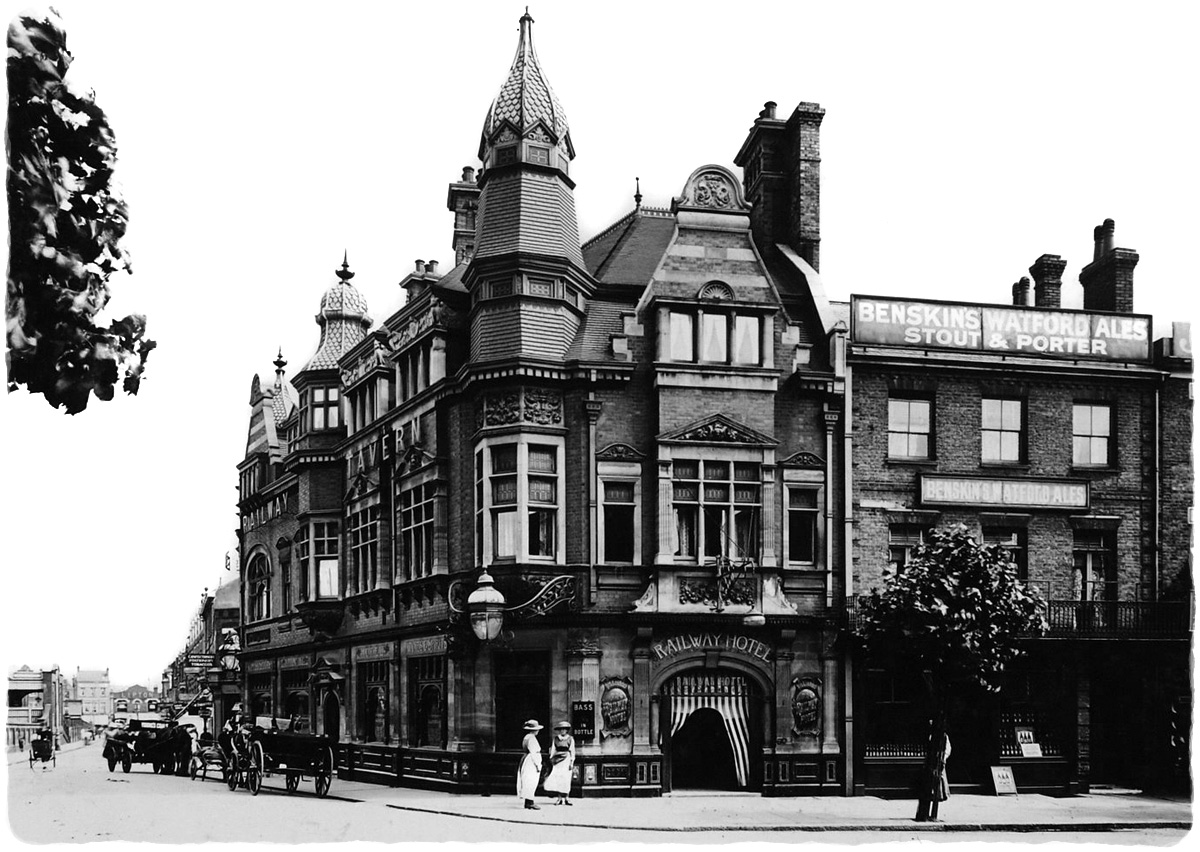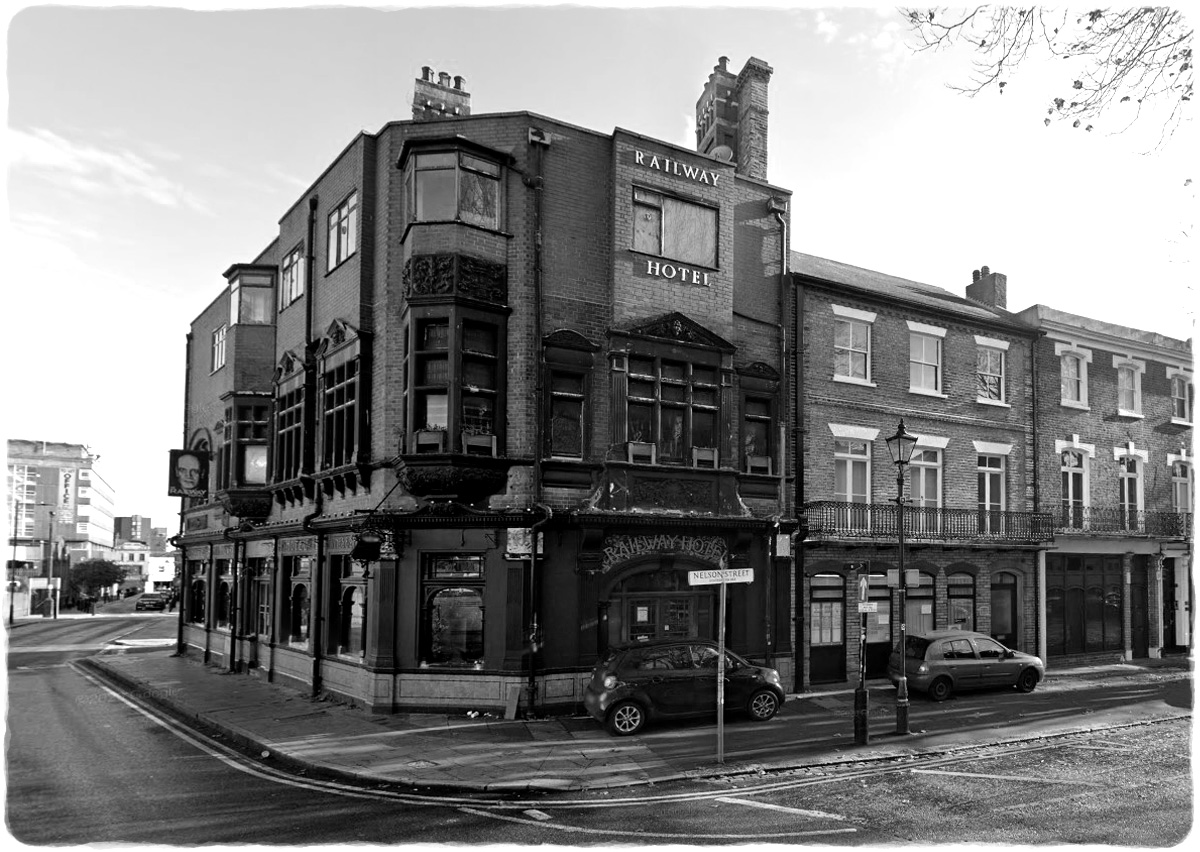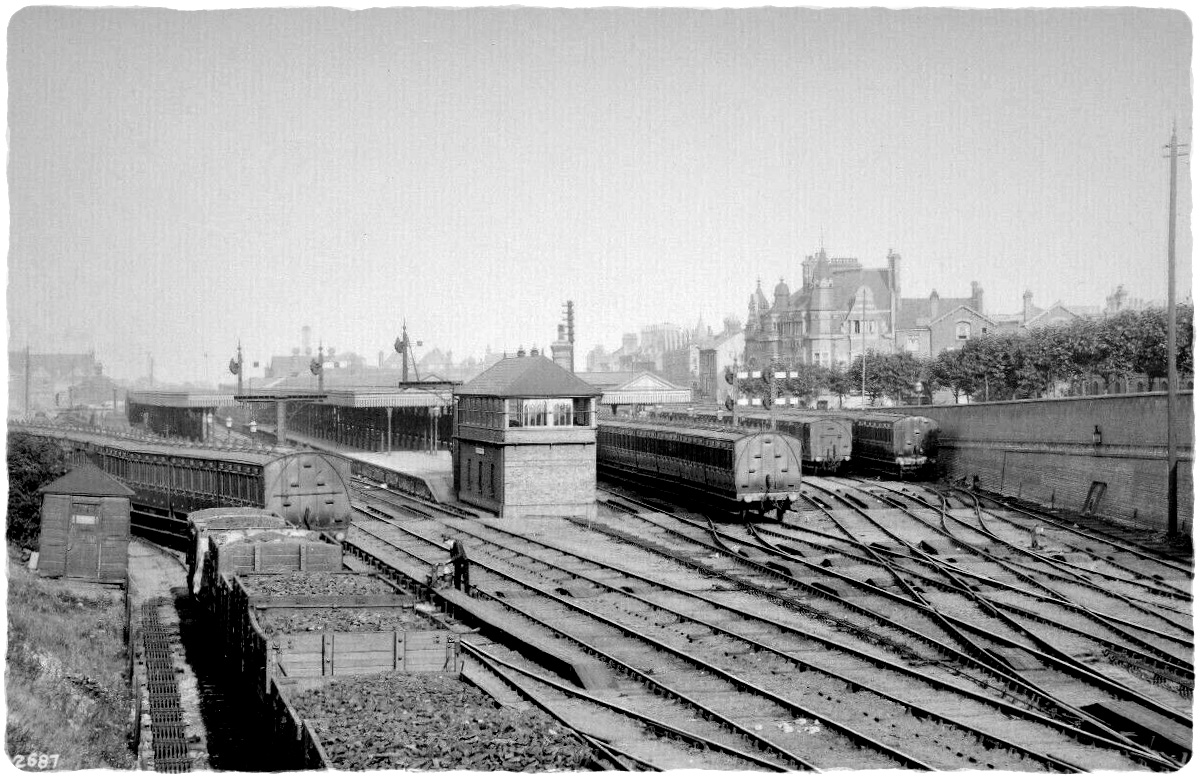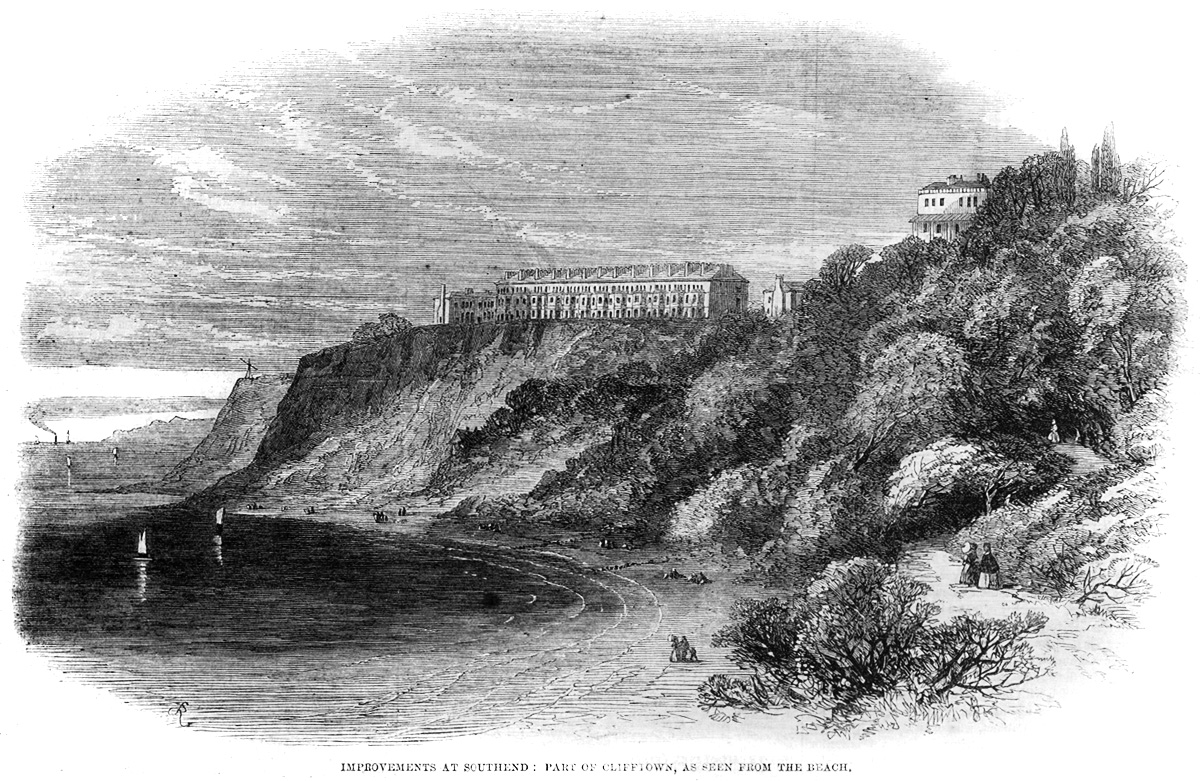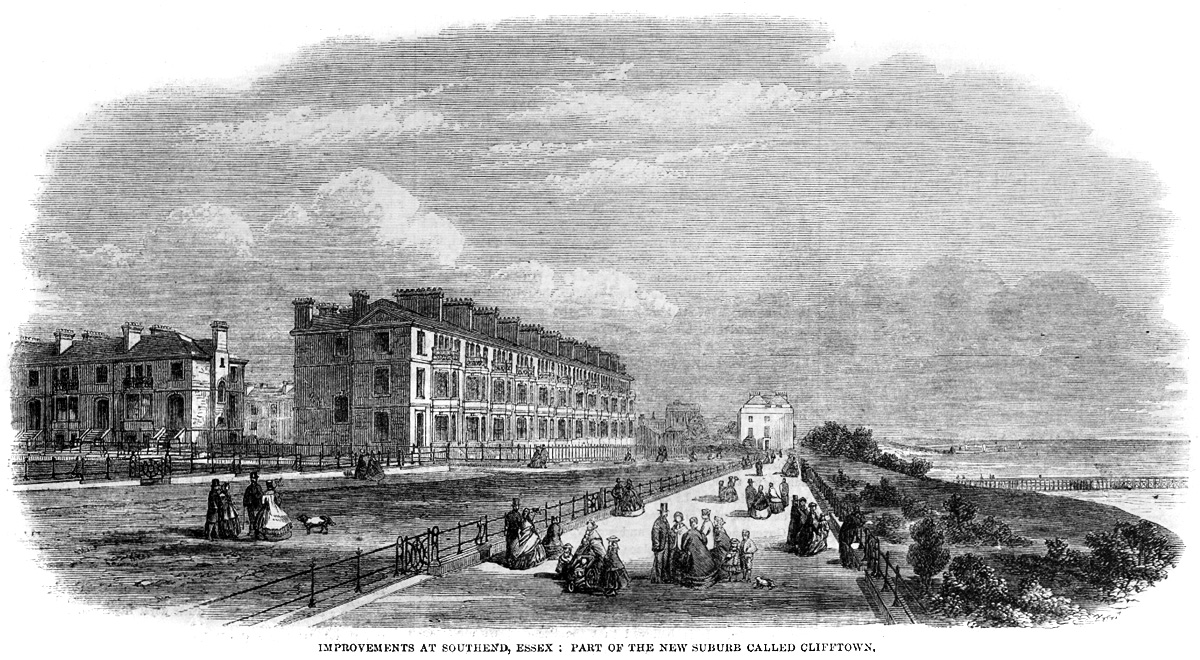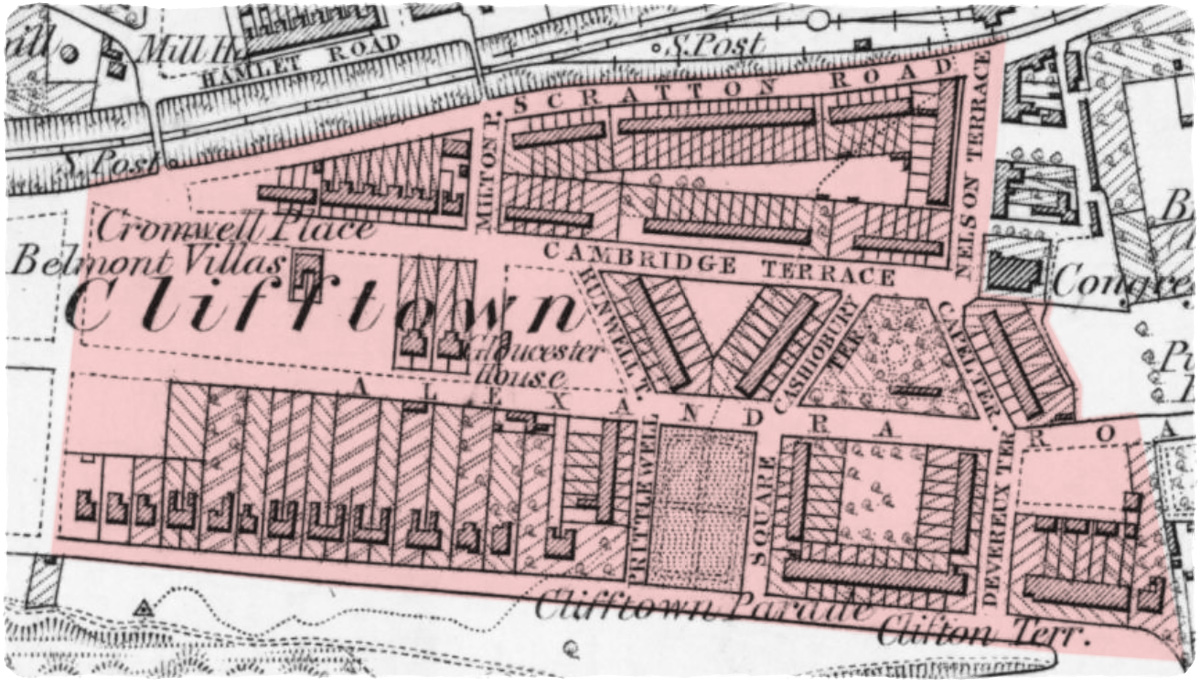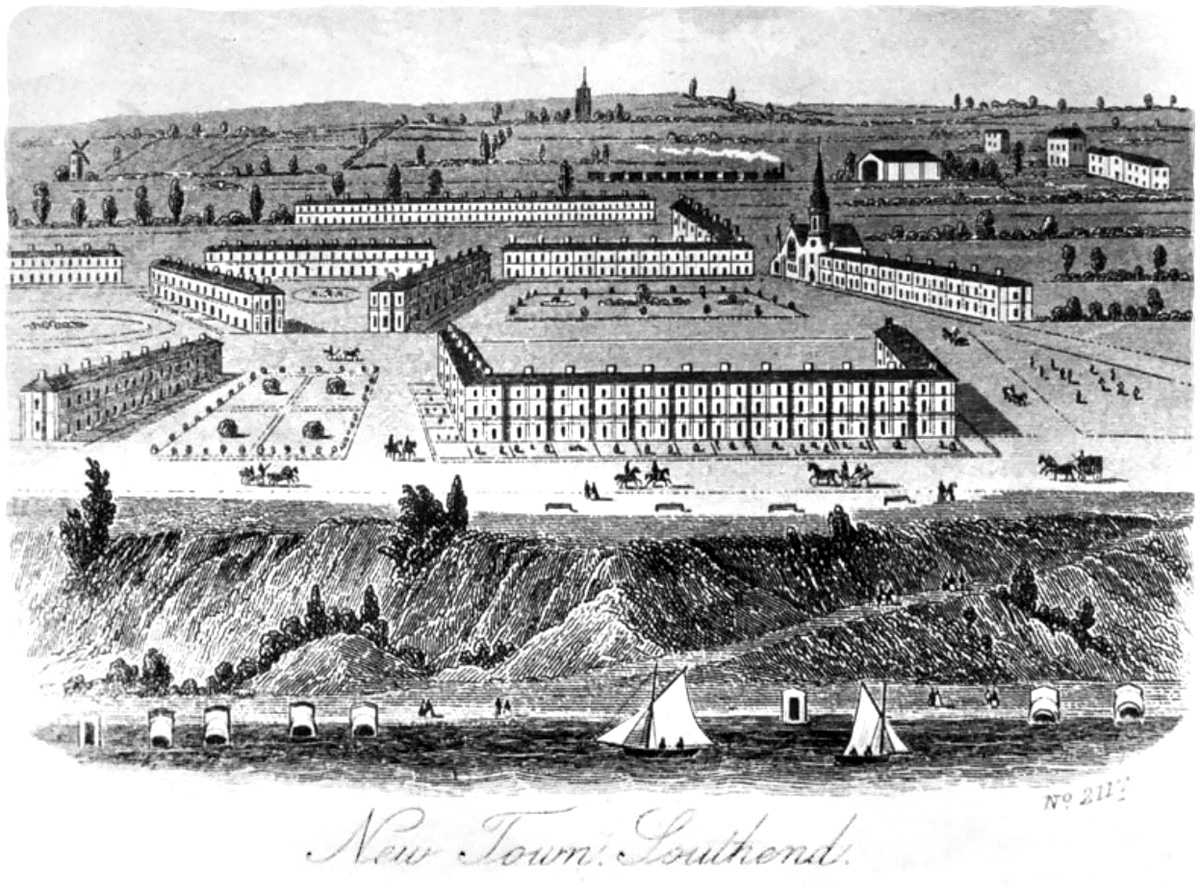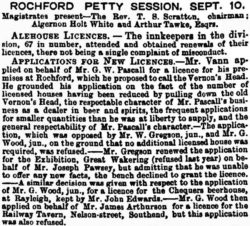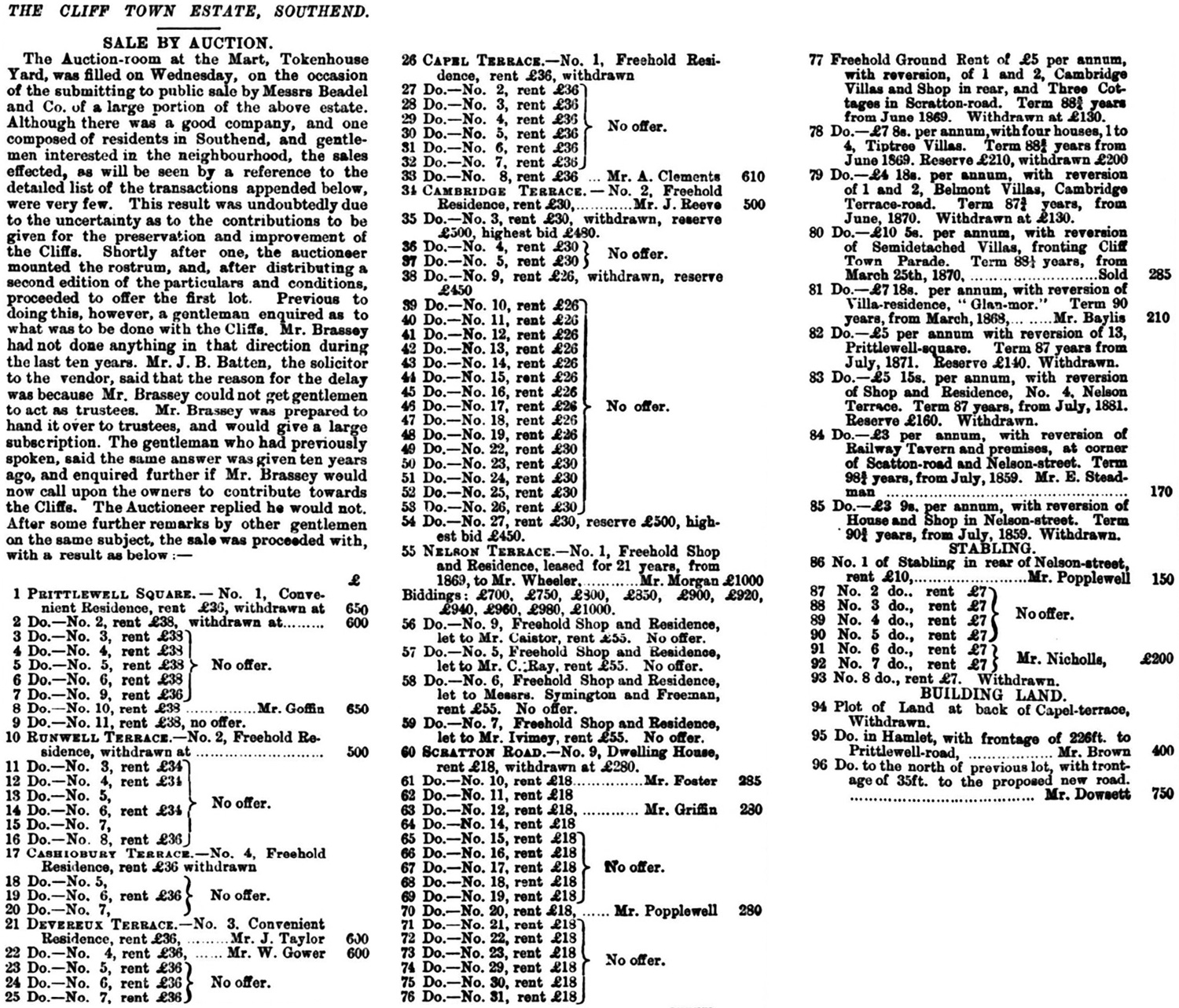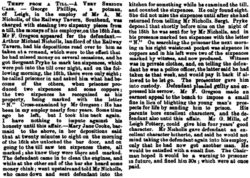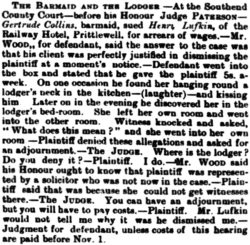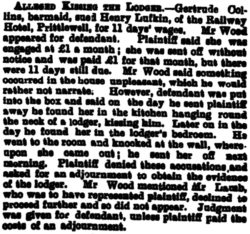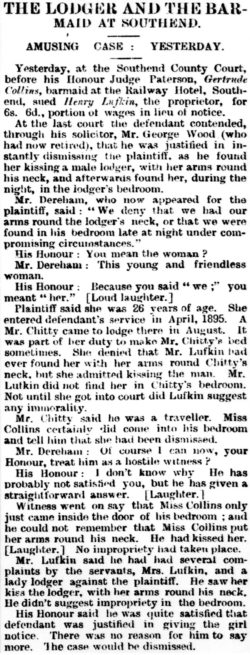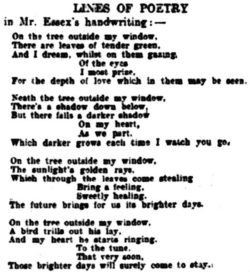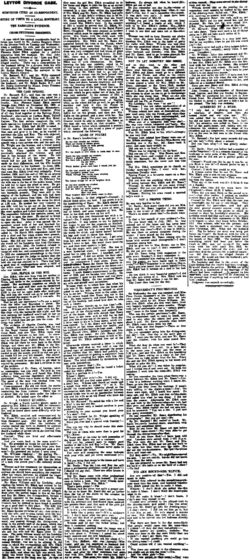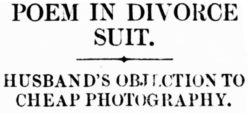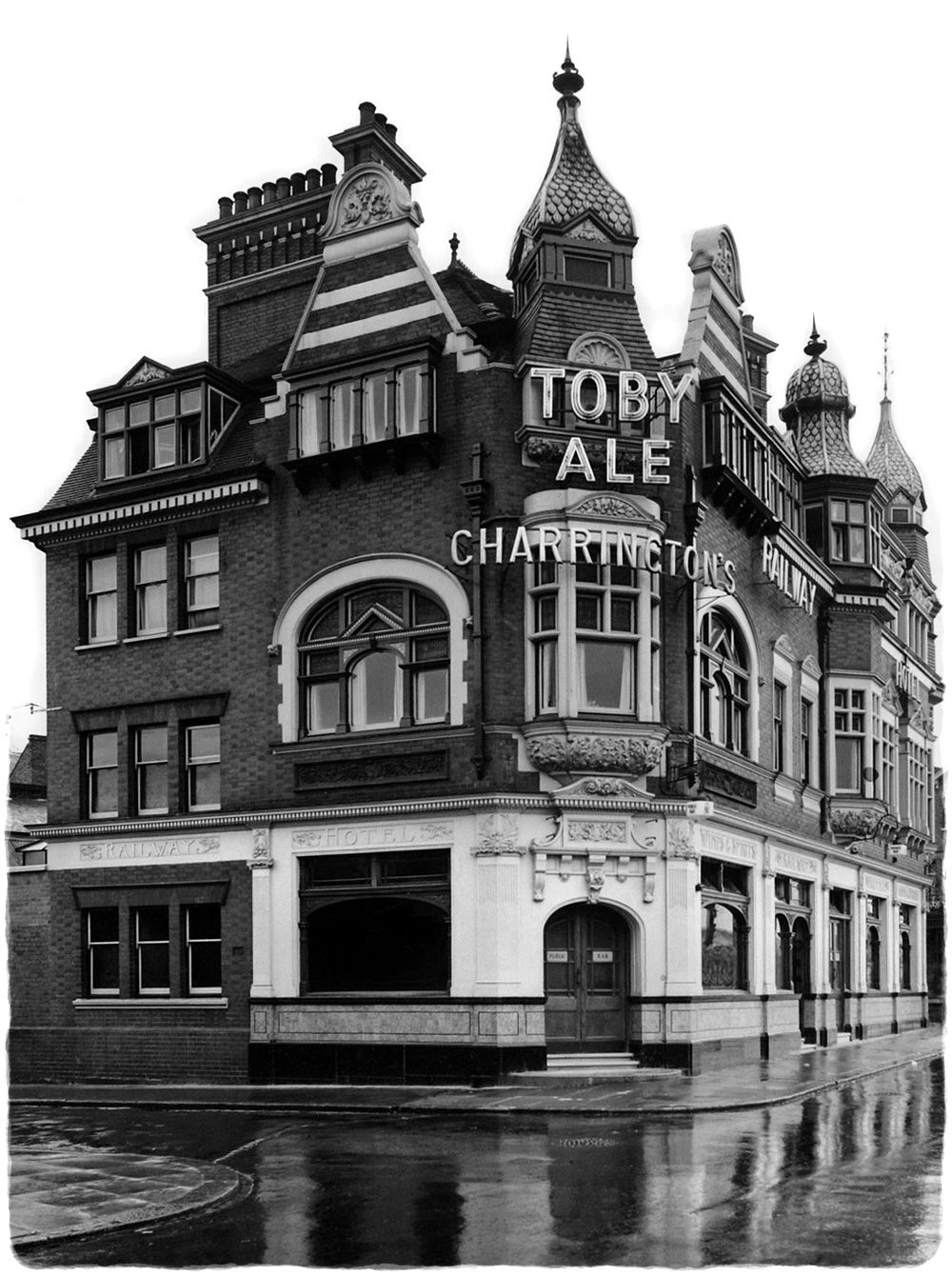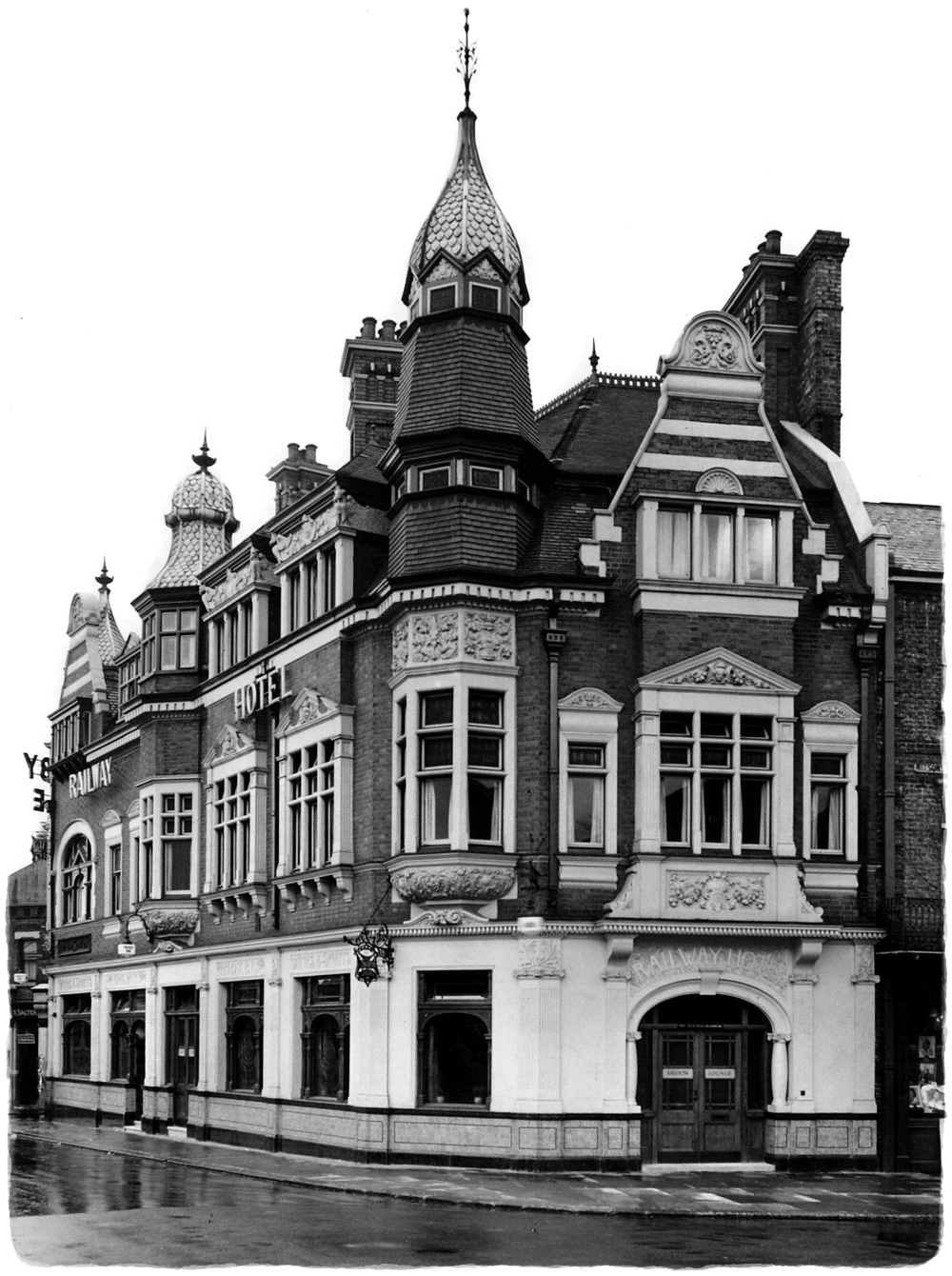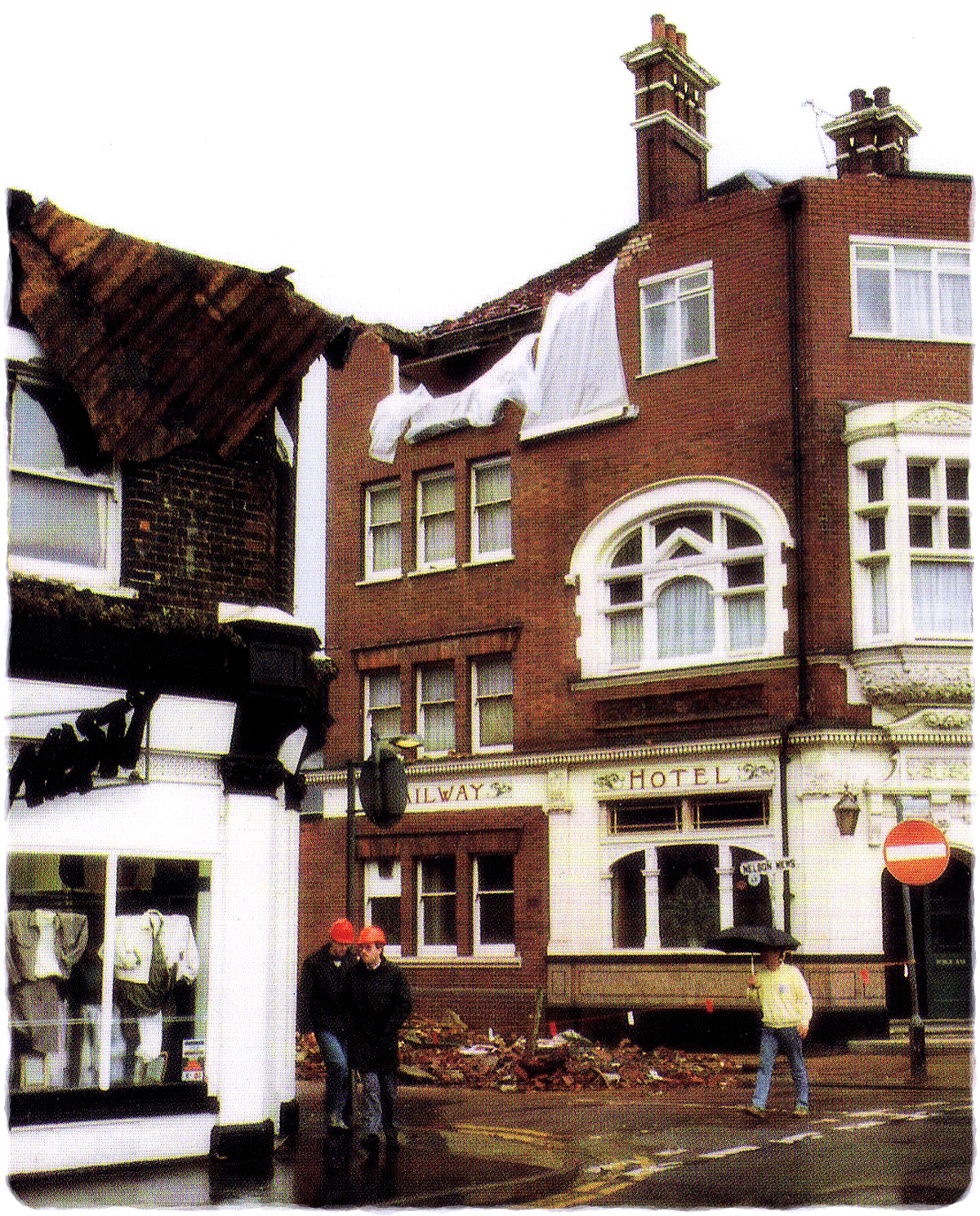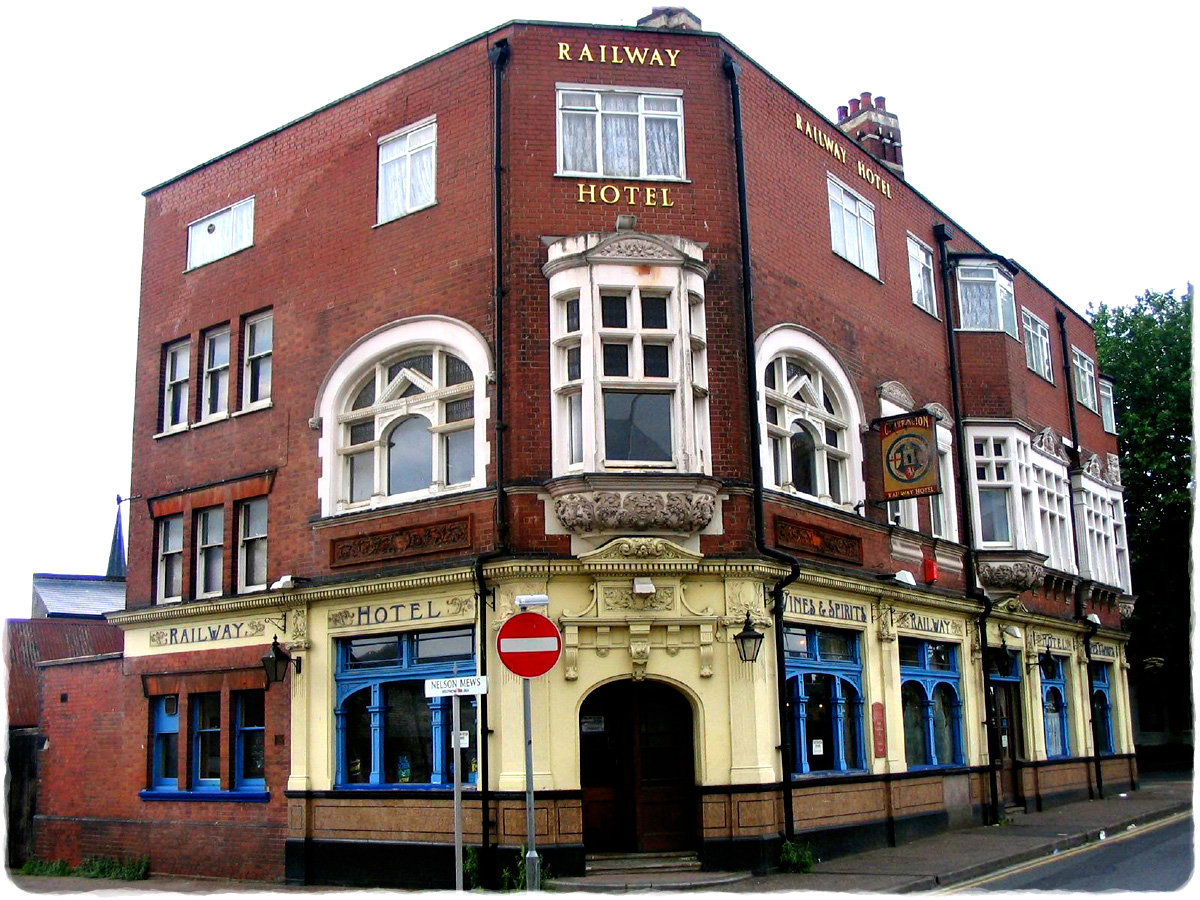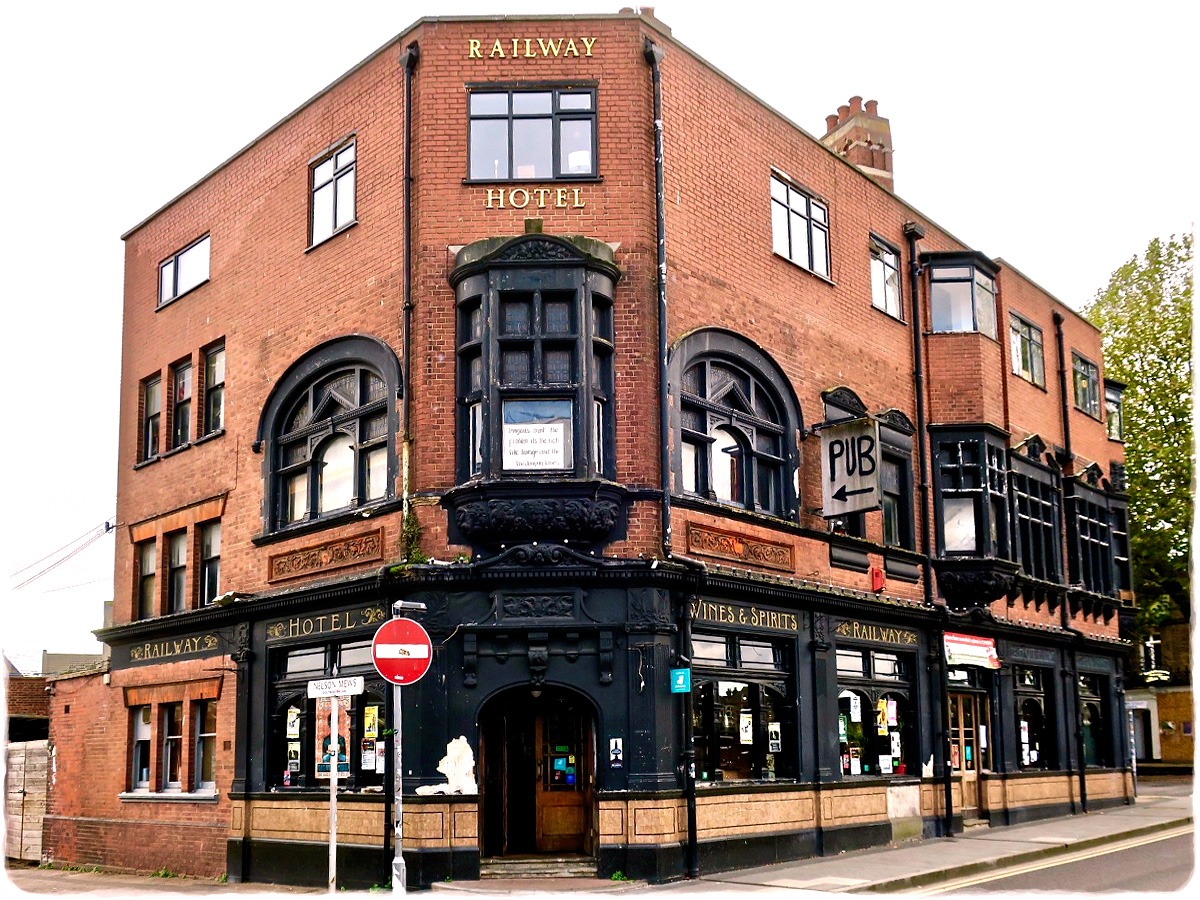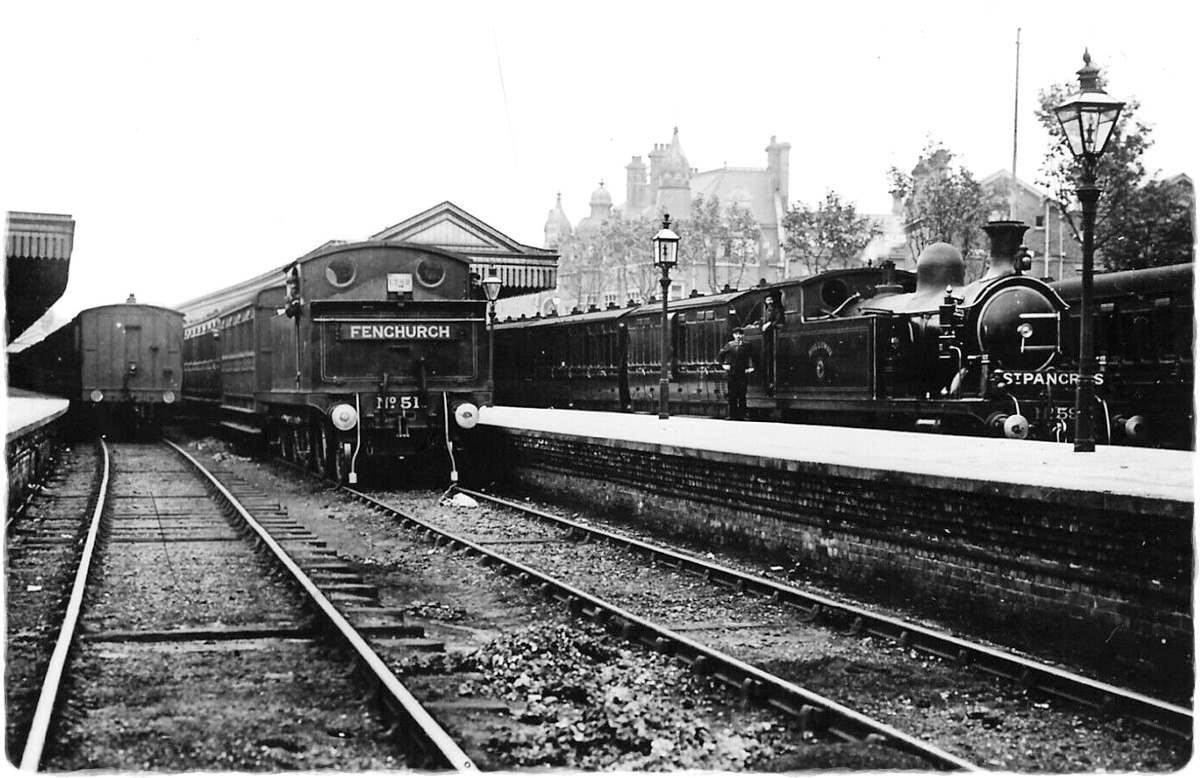Railway Hotel is situated at the end of Clifftown Road, in the Cliff Town conservation area of Southend-On-Sea, Essex. The building and business date from c.1868, and traded almost continually up to its current closure in Apr 2021.
The pub was originally called the Railway Tavern and addressed “Nelson Street” onto which it also abuts. Nelson Street was built between 1859-1861 and was designed as the first shopping area for Southend before the High Street was developed. It would have been a busy area with the newly opened railway station across the road, and the perfect place to build a hotel and public house.
The wonderful photograph on the left below (which I have edited and cleaned up) was taken in 1919 by the Charrington Brewery and was one of hundreds of pub photos saved from a skip in the 1970s (all of which can be seen Flickr, thanks to the National Brewery Heritage Trust). Note the lettering “RAILWAY TAVERN” on the front of the building, with “RAILWAY HOTEL” above the door. The building no longer has the Dutch gables or wonderful fancy turrets (as shown in the photo on the right from 2021), but very similar gables can still be found further along Clifftown Road at no.’s 21-25 on what was once a stretch of five terraces (originally six), and which also have similar decorations above the windows. Properties along Clifftown Road were built between 1881-1891 after the High Street began to take shape, with numbers 21-25 being a later addition built on the last vacant plot sometime between 1895-1901. From 1897 to 1899 the Railway Hotel underwent some alterations, and I wonder whether the roof decorations and some of the façade were added at this time.
Some internal refurbishment was undertaken during the interwar years by Charrington Brewery, as well as a few minor exterior alterations, but the biggest external change was the complete change to the roofline. The turrets and gables were removed, and the wall line extended up above the second floor to appear almost flat from street level.
- Railway Hotel, 1919 (thanks to the National Brewery Heritage Trust)
- Railway Hotel, 2021 (thanks to Google Maps)
The Railway Hotel made quite an entrance into Southend station at one time, as seen on the right.
- Railway Hotel as viewed from Southend Station
The History and Development of Cliff Town, Southend-On-Sea
From the late 17th century onwards, the SCRATTON family owned many hundreds of acres of farmland around Southend and Prittlewell, along with Prittlewell Priory and Milton Hall (now Nazareth House). The 1841 Tithe records for Prittlewell recorded John Bayntun SCRATTON as owner and occupier of over 2000 acres of land, including the area which would become Cliff Town in 1859. John’s son Daniel inherited his father’s estate on his death in 1842.
The Southend to Tilbury railway line was completed in 1854 by Sir Samuel Morgan PETO, Thomas BRASSEY and Edward BETTS, and the following year built the Grand Crimean Central Railway, a supply and casualty transport route used during the Crimean War. Southend saw the addition of gasworks in 1855 and waterworks from 1856.
On 1st Jul 1859, Sir Samuel Morgan PETO signed a 99-year lease for 40 acres of land in Southend belonging to Daniel Robert SCRATTON, stretching from the new railway line down to the shore, covering land called “Shorefield” and “Millfield”. Peto, Brassey and Betts, along with builder brothers Charles LUCAS and Thomas LUCAS and architects BANKS & BERRY, went on to design the new Cliff Town development in Southend and laid the first stone four months later on 3rd Oct 1859.
On 1st Jun 1861, the Illustrated London News ran a full-page article about the nearly completed suburb, with two lovely illustrations.
“The accompanying illustrations represent the new suburban town on the cliff at Southend, Essex, which had been projected and carried out by Sir Morton Peto, Mr. Brassey, and other large contractors, and which is now all but completed. Clifftown consists of 124 houses, which have been erected at a total cost of above £100,000, and it is proposed that persons desiring to occupy them may either become tenants at a fixed rent, or may gradually assume proprietorship by the payment of annual sums over a period of years. The views of the opposite coast of Kent are beautiful from here ; and the constant passing of vessels up and down the mouth of the Thames to and from all parts of the world gives life and variety to the prospect. It is stated that arrangements have been entered into with the Tilbury and Southend Railway Company to run express-trains to and from London and Southend within an hour and a quarter, and also to issue season tickets and reduced rates. The enterprise has been carried out with great spirit, and we trust it may be successful, as it helps to supply a want which the overworked middle classes of London experience.”
Newspaper articles throughout reproduced with the permission of the British Newspaper Archive and The British Library Board.
- Illustrated London News – Saturday 01 June 1861
- Illustrated London News – Saturday 01 June 1861
The completed 124 houses were advertised in Mar 1861 as ready to let, with “unrivalled views of the sea and the opposite coast“. Their water was supplied by the newly built Southend Water Works, and the streets were lit with gas. The properties were arranged into three classes, differing in size, proportion and rental. Most of the 124 houses were occupied by 1862, and consisted of:
- 12 houses in 1 terrace facing the sea with 14 rooms each
- 45 houses in 6 terraces with 10 room each
- 27 houses in 3 terraces with 7 rooms each
- 32 houses in 6 terraces with 6 rooms each
- 8 houses in 1 terrace built as shops, with 10 rooms and 2 store rooms each [west side of Nelson Street]
The map below (surveyed 1873 and published 1880) highlights the original Cliff Town area. The Congregational Church was built in 1865, as shown on the delightful illustration to the right, with the east side of Nelson Street (called Nelson Terrace on the map) and the Railway Hotel at the top yet to be built. All were in erected by 1867, and the first landlord of the pub was James ARTHURSON. I haven’t discovered who actually build the property.
Maps reproduced with the permission of the National Library of Scotland.
- Map Surveyed 1873 & Published 1880
- Cliff Town Estate c.1865
Licensees and Owners of The Railway Hotel – 1868 to 1962
Using census and electoral records, directories and newspaper articles, I have discovered nearly 100 years of occupancy from 1868 to 1962. The licence to the Railway Hotel changed hands many times over the course of ten decades.
- 1868-1873 – James ARTHURSON (Licensee)
- 1873-1875 – Robert BARRATT (Licensee)
- 1875-1895 – Arthur Michael NICHOLLS (Licensee)
- 1882-1897 – Edwin STEDMAN (Owner)
- 1895-1897 – Henry LUFKIN (Licensee)
- 1897-1900 – James John WAGSTAFF (Owner & Licensee)
- 1900 onwards – Charrington Brewery (Owners)
- 1900-1914 – Henry BROWN Jnr, with George John ELFICK as Manager (Licensees)
- 1914-1929 – Henry CHALLIS (Licensee)
- 1929-1935 – Mable Mary NAPIER (Licensee)
- 1935-1937 – Frederick William BOYDEN (Licensee)
- 1937 – Ms E. T. REEVES (Licensee)
- 1938-1940 – Henry CHALLIS (Licensee)
- Aug 1940 to Apr 1941 – PUB CLOSED
- 1941 – Mr A BENALO (Manager until at least 1962)
–
James ARTHURSON was the first licensee and landlord of the newly built Railway Tavern from 1868.
James ARTHURSON was born in Lerwick, Sheland, Scotland on Christmas day 1817, and was the son of a cooper of the same name. He joined the Royal Navy in 1838, having already spent time at sea, and also worked as a cooper like his father. James married the very recently widowed Eliza SWADEN, nee STEDMAN on 16th Dec 1856. James was still serving in the Navy at the time, and residing in Minster, Isle of Sheppey, Kent.
Eliza STEDMAN was born in Northfleet, Kent in 1813, and prior to marrying James had first married John SWADEN on 23rd Apr 1837 in London. They were both working as servants for a Sugar Refiner when the 1841 census was taken, and living in Goodmans Fields near Whitechapel. By 1855 the couple had moved to the Old Jolly Sailor at 16 West Street, Blue Town, Kent. John died the following year after a lingering illness on 5th May 1856 age 52 (they never had children). A few short months later Eliza, now age 43, married James a few days before his 39th birthday. Whilst he was away working with the Navy, Eliza continued to run the Old Jolly Sailor until he was discharged in Jul 1860 and the couple then ran the pub together until 1867 when they moved to Southend. They didn’t have any children together.
James applied for a new licence to the Railway Tavern on 10th Sep 1868 but was at first refused (as were all three other applications for new licences). He was clearly successful shortly after this as by the time the 1871 census was taken James was working as a licenced victualler from the recently built Railway Tavern listed between “5 Nelson Street” and “1 Nelson Terrace”. His wife Eliza and one servant (Martha J HIDE, age 14) were also present.
- Essex Herald – Tuesday 15 September 1868
By 1874 the couple had moved to 11 Albyn Terrace, Queen’s Road in Southend where James died on 4th Oct 1878 aged 61. Eliza died not long after on 19th Mar 1880 age 67, and her probate record shows one of her two Executors to have been Edwin STEDMAN, who went on to purchase the Railway Tavern two years later when a majority of the Cliff Town estate was put up for auction. I haven’t been able to confirm Eliza and Edwin’s exact relationship but may have been cousins. Her other Executor was Samuel DARKE of 3 Scratton Road, a builder who lived just along the road. Samuel built (and was employed by others to build) several properties in the local and surrounding area from the 1880s onwards.
–
Edwin STEDMAN bought the Railway Tavern in 1882 but never lived or worked there.
Edwin STEDMAN was born in 1837 in Detling, Kent. He worked as a butler for several years and married housekeeper Mary KEEN in 1869. They were working together in the same household in 1871, and Edwin was able to retire in his early 40s to Southend where he and his wife moved in with Eliza ARTHURSON, nee STEDMAN, at 11 Albyn Terrace (I don’t know if this was before or after Eliza’s husband James died). Edwin and Mary continued to live at 11 Albyn Terrace after Eliza died in 1880 and were recorded there in the 1881 census.
A huge auction took place on Wed 25th Oct 1882, compiling of ninety-three properties in the Cliff Town area, including the Railway Tavern (lot #84). Only twelve sold, as many of the interested buyers had concerns over the long-term preservation and improvement of the Cliffs. The Railway Tavern was bought by Edwin STEDMAN for £170 (about £14k today) with a Freehold Ground Rent of £3 per year under a term of 98 3/4 years dating from Jul 1859.
- Southend Standard and Essex Weekly Advertiser – Friday 27 October 1882
Edwin and wife Mary had moved from Southend to Atherstone, Warwickshire by 1885, the county of Mary’s birth and where they had both worked for many years. Edwin owned the Railway Tavern until 1897 when he sold it to James John WAGSTAFF, which was shortly before his death on 5th Jun 1900 aged 65.
–
Robert BARRATT took over the licence from James AURTHORSON in 1872/73.
The licence to the Railway Tavern was taken over in 1873 (or possibly 1872) by Robert BARRATT, who left Southend on 28th Jan 1875. He must have been well-liked as his departure from the station opposite was accompanied by the town band and a number of leading tradesmen, but sadly I haven’t been able to find out anything about him. After Robert’s departure, the band returned to the pub to entertain the new landlord, Arthur Michael NICHOLLS.
–
Arthur Michael NICHOLLS took over the licence from Robert BARRATT in 1875.
Arthur Michael NICHOLLS was born on 11th Mar 1842 in St James Westminster, London. His father, Michael NICHOLLS, was a currier journeyman (leather worker), and Arthur followed in his footsteps. He married Jane HARRIS c.1870 when she was about age 18, and they were living in Camberwell when the 1871 census was taken. At this time Arthur was employing 3 men, and Jane gave birth to their first child nine weeks later on 8th Jun. Their second child was born in the spring of 1874 in London, and the family then moved to Southend where Arthur took over the licence of the Railway Tavern.
When the 1881 census was taken, Arthur was recorded as a licenced victualler and living with his wife Jane and daughter Mary. Also present were barmaid Mary J COOK (26), general servant Alice NUNN (20) and potboy George PHILLIPS (17). Their son Henry was not home at this time, most likely away at school aged 10.
Their daughter sadly died on 21st Aug 1888 at the age of 14 and was buried at St John the Baptist Church. Arthur and Jane were still running the Railway Tavern in 1891, and their son was back home. Henry was now age 19, studying medicine, and just become a Second Lieutenant in the 1st Kent Royal Artillery Volunteer Corps. Arthur had diversified into farming oysters, alongside running the pub. Also living with the family when the census was taken was visitor Kate MITCHELL of no occupation (28), barmaid Jane COOK (32), domestic servant Ada COLE (20), and potman William DIXEY (42).
Henry passed his examination in Elementary Anatomy and Elementary Physiology in Aug 1891, but two years later in Feb 1893 was declared bankrupt. He had amounted debts of £1878 17s 6d (roughly £168k today), despite his father giving him a yearly allowance of about £250 (nearly £10k in today’s money). Over the past two years, Henry had been letting his studies slide, gambling, lending and borrowing money. Some of his debts dated back to money lent as a child against his grandfather’s will. A method of repayment was worked out at court, where all these facts had come to light.
In Jan 1895 it was Arthur who was in court this time, due to his potman George PHILLIPS (possibly the same George who was working for Arthur 1881) stealing two sixpenny pieces from the till. Arthur had noticed money going missing previously, so Sergeant PRYKE was employed to mark ten sixpences with “N” and return the to the till in order to catch the culprit red-handed. The scheme worked, and George was found with the marked coins in his pocket shortly after starting work. He was fined 30 shillings (roughly £150) rather than being sent to prison, in the hope it would deter him from trying anything like it again.
- Southend Standard and Essex Weekly Advertiser – Friday 23 January 1885
By the Apr of 1895, Arthur had given up the pub trade to take on the oyster business full time, whilst son Henry had climbed out of debt and joined the Royal Army Medical Corps. By 1901 Arthur and Jane had moved east to Paglesham next to the River Roach (with a cook and a housemaid) where he set up oyster beds.
By the time war broke out in 1914, son Henry had been promoted to Lieutenant Colonel. Arthur died in Pagleshame aged 78 (although recorded as being 80) at the end of May 1920, and was buried at St. John the Baptist, Southend on 2nd Jun. His widow Jane moved back to Southend and died Feb 1828 aged 76. She was also buried at St. John the Baptist, on 15th Feb.
–
Henry LUFKIN took over the licence from Arthur Michael NICHOLLS in 1895.
Henry LUFKIN was born in 1854 in Tollesbury, Essex and the son of a farm labourer. He married widow Mary Ann Eliza GOODY, nee MOSS 21st Oct 1871 in Tolleshunt D’Arcy, Essex. Mary had two children from her previous marriage to Thomas James GOODY, who died in 1869 aged 28. Henry, Mary and her daughter were living at Gowles Farm in Leigh-On-Sea when the 1881 census was taken, where Henry was working as a stockman. By 1884 they had moved to the King’s Head on North Street, Prittlewell where Henry took over the licence. During the same year Mary’s unmarried daughter Esther, age 19, gave birth to a daughter of her own who Henry and Mary cared for whilst Esther worked as a domestic cook in London. They never had any children of their own together.
Henry took over the licence of the Railway Tavern in or just before Apr 1895, which was to be a brief but notable tenure. It was also at this time the Railway Tavern became to be known more regularly as the Railway Hotel. In Oct 1895, Henry was taken to court by former barmaid Gertrude COLLINS and sued for 11 days of unpaid wages. He had cause to dismiss Gertrude on the spot after allegedly finding her kissing the lodger, then later found in his bedroom. Gertrude denied the accusations at court, and the case was adjourned in order to obtain evidence from the lodger, Mr CHITTY. When the case returned to court Gertrude now admitted to kissing the lodger, but both denied she came into his bedroom. Judge PATERSON found in favour of the defendant and the case was then dismissed.
- Essex Standard – Saturday 12 October 1895
- Southend Standard and Essex Weekly Advertiser – Thursday 17 October 1895
- Chelmsford Chronicle – Friday 08 November 1895
Henry had swiftly moved on from the Railway Hotel to the Rose Inn in Maidstone, Kent by Sep 1896, but looks to have spent time in Eastwood in between. On 17th Sep he was summoned for non-payment of Poor Rates (£2 11s). On 19th Sep it was stated to be 15s 6d at the Southend Borough Police Court, and on 22nd Sep failed to appear at the Southend Borough Petty Sessions (described as “of the Rose, Maidstone“). On 1st Oct he was described as “late of the Railway Hotel” and committed for ten days for non-payment of Eastwood Poor Rate, with 8s 6d costs.
Henry had changed pubs again by Jul 1897 and was now landlord of the Hearts of Oak in Maidstone. His wife Mary died the following year in mid-1898 age 53. On 14th Dec 1903 Henry re-married to Sarah HOWE and by 1911 had moved to Bourne Poultry Farm, Albert Road, Parkstone, Dorset where he was working as the manager (age 58, but stated to be 55). Sarah died in early 1915 age 68, and Henry had moved back to Essex in the Braintree area by 1921, where he died in early 1924 age 71.
–
James John WAGSTAFF took over the licence from Henry LUFKIN in 1897.
James John WAGSTAFF was born in 1832 in Christchurch Spitalfields, London, and the son of a coach builder. At the age of 19 James was working as a greengrocer but changed career to become a butcher by the time he married Ann ROUTLEY (also recorded as ROUTLIFF) on 29th Aug 1855 in Thames Ditton, Surrey. He was a master butcher by 1861 and by 1881 the couple had born eight children, sadly losing three quite young and in close succession. The family moved from Poplar to West Ham by 1890 where James gave up butchery in favour of being a “beer housekeeper and retailer” (1891). He went on to purchase the Northumberland Arms in Plaistow, and later a shop at Custom House which he turned into an off-licence. Business went well and James soon after sold off both businesses and the family to Southend-On-Sea in 1893.
James joined the Freemasons in 1894 when he was age 62 and being of “no profession“. It was now that James ventured into development in and around the Southend area with architect James THOMPSON, building 13 houses on Southchurch Road, a further 6 houses on St Vincent’s Road, 4 houses on Westcliff Parade and Albert House on Milton Road (no longer there). His biggest investment by far was the Queen’s Hotel on Hamlet Court Road in Westcliff-On-Sea, which he first submitted plans for in 1896 using architects THOMPSON & GREENHALGH.
James bought the Railway Hotel leasehold in 1897 from Edwin STEDMAN, and over the next two years made several alterations to the building (to which he was noted to be the owner). Some of these alterations were most likely the addition of Dutch gables and fancy turrets to the roof, and possibly even the façade. The overall look of the building is very similar to other hotels designed at this time by THOMPSON & GREENHALGH; the Queen’s Hotel and Hotel Victoria, and also the Hotel Metropole later called Palace Hotel. The Queens Hotel had its grand opening in 1899, and like the Railway Hotel, would become an alternative music venue several decades down the line. It was demolished ninety years later in 1989.
James is listed in Kelly’s Directory at the Railway Tavern from 1898 to 1900. The 1900 electoral roll for ownership electors lists his abode as Standfield, St. Vincent Road, Southend with his nature of qualification as “Freehold Land & House” at plots 34, 25, 29 to 38, 41 to 43 St. Vincent Road. James’s son George was listed on the electoral roll for occupation electors living at the Railway Hotel in 1900. In 1900, James sold the lease to the Railway Hotel with 50 years remaining to the Charrington Brewery, and on 20th Nov of that year the licence was transferred from James to Henry BROWN Jnr who then employed his brother-in-law George John ELFICK as manager.
When the 1901 census was taken, James and his wife Ann were living at 110 Southchurch Road (which he built), and his occupation was listed as “licenced victualler”, presumably relating to the Queen’s Hotel. The electoral roll for occupation electors in 1901 lists James’s abode as the Railway Tavern, and his nature of qualification as “Dwelling Houses (successive)” at Railway Tavern, Nelson Street, and St. Vincent Road, and the electoral roll for ownership electors between 1901-1902 also lists James’s abode as the Railway Hotel (rather than Tavern). However, he did not live there at any time after 1900.
On 1st Oct 1902, James’s wife Ann died aged 68. Not to let the grass grow, he remarried the following year on 23rd Jan 1903 to Margaret CRIPPS, a mere fifty years his junior (James was 71 and Margaret 21). Their first and only child was born in 1904, and around 1905 James sold the Queen’s Hotel for £50,000 (well over £4m today). He then bought a large amount of land in Eastwood, an area he had been making bricks for his construction work since 1898. James was still submitting building plans the year he died, which happened on 18th May 1909 at age 77. He left his brickfields and machinery to his widow and children, and his stocks and shares in the Queen’s Hotel were sold and divided amongst them. The residue was left as income to his widow and youngest son until he came of age when he could claim half. Sadly, Margaret died on 26th Dec 1917 aged 35, leaving their son orphaned at age 13.
- Southend Standard and Essex Weekly Advertiser – Thursday 20 May 1909
–
Henry BROWN Jnr took over the licence from James John WAGSTAFF on 20th Nov 1900.
Henry BROWN Jnr was born in 1868 in Poplar, London. His father, Henry Snr, was a licenced victualler and the family moved from London to Belgrave Villa, Cliff Town Road, Southend between 1881-1891. Henry took over the licence and running of London Hotel on the High Street on 3rd Jun 1891, and married Rebecca Mary Ann ELFICK on 12th Apr 1894 in Prittlewell with three children born in 1896, 1897 and 1898 in Southend. By 1900 Henry and his brother James jointly owned the London Hotel. On 20th Nov 1900, Henry took over the licence to the Railway Hotel, for which he had acquired the lease from the Charrington Brewery who had themselves recently purchased the building from James John WAGSTAFF. Henry’s brother-in-law George John ELFICK was hired as manager and living there when the 1901 census was taken. Henry and family were living at Paglesham House (a pub), Paglesham at this time, working as a hotel keeper. A fourth child was born in 1902.
On 14th Apr 1903, Henry transferred a temporary licence of the Railway Hotel to George John ELFICK, and on 13th Mar 1906 Henry took over the licence of the Alexandra Hotel in Southend. He transferred the licence to the Alexandra Hotel on 11th Feb 1908 to another brother-in-law, John William ELFICK, and shortly after that on 18th May 1908 transferred the full licence of the Railway Hotel to George. George had moved to Leyton, Essex by 1909 and Henry’s brother James BROWN took over the running of the pub. James was living in the Railway Hotel when the 1911 census was taken, working as a licenced victualler. Three out of four of Henry and Rebecca’s children were living at Paglesham House in 1911, along with their 28-year-old aunt Daisy ELFICK, who was listed as “sister-in-law” to the head of the household. Henry and Rebecca, however, are nowhere to be found. Henry took back control of the Railway Hotel in Mar 1913, although I don’t think he actually moved in. The BROWN family were present in the Southend area when the 1921 census was taken, but I haven’t been able to confirm when either Henry or Rebecca died.
–
George John ELFICK worked as Manager for his brother-in-law Henry BROWN from 1900, before taking over the licence between 1903 to 1908.
George John ELFICK was born on 11th Nov 1872 in Gravesend, Kent. His father (John) worked as a waterman and also a licenced victualler in Milton, Kent until his death in 1895. When the 1891 census was taken George was age 18 and working as an architect and surveyor, but by Dec 1899 had taken over the licence to the Pier Hotel in Maidstone and his brother John was running the Shoeburyness Tavern in Shoeburyness, Essex. George’s sister Rebecca married Henry BROWN in 1894, and after taking over the Railway Hotel in 1900 employed George as its manager. George was living in the Railway Hotel when the 1901 census was taken, age 28 and unmarried. Also living with him was his sister Daisy, barmaid Beatrice COLLIN (19), barman Stephen PARISH (22), cook Hannah SULIVAN (33) and handmaid Jessie BARNARD (20). On 21st Dec of that year George was sworn in as a member of the Essex Imperial Yeomanry, along with his brother and brother-in-law.
The licence to the Railway Hotel was temporarily transferred from Henry BROWN to George on 14th Apr 1903, and later the following year on 8th Nov 1904 married Florence Mabel ALLEN in Bloomsbury, London. Florence’s father was also a licenced victualler. George continued to run the Railway Hotel until 18th May 1908 when the licence was transferred back to Henry. George and Florence moved briefly to Tufnell Park, London before George took over the licence to the Lion & Key Hotel in Leyton, Essex in Jul 1909. The couple were found there when the 1911 census was taken, married for six years with no children, but things were not going well between the couple and on 15th Jun 1912 Florence filed for judicial separation on the grounds of alleged cruelty by her husband. The following month, George filed a cross-petitioned for divorce on the grounds of his wife’s alleged misconduct with Ernest Henry ESSEX, a married surveyor to the Leyton District Council. The case came before the High Court of Justice in Nov 1913, and all parties gave evidence to which all denied. One piece of evidence, in particular, sparked interest in newspapers up and down the country, that of some handwritten poetry by Ernest found amongst Florence’s belongings. The Walthamstow and Leyton Guardian ran a very detailed article of the court case, which was dismissed on both counts due to both parties having condoned each other’s behaviour during their marriage.
- Walthamstow and Leyton Guardian – Friday 14 November 1913
- Walthamstow and Leyton Guardian – Friday 14 November 1913
These are some of the amusing headlines, “Husband’s Objection To Cheap Photography” being my favourite!
- Daily Citizen (Manchester) – Wednesday 12 November 1913
- Leicester Daily Post – Thursday 13 November 1913
- London Evening Standard – Thursday 13 November 1913
- Barrow Herald and Furness Advertiser – Saturday 22 November 1913
The couple went their separate ways after this. George travelled to Australia where on 20th Aug 1914 he enlisted into the 3rd Light Horse Regiment, just a few days before war was declared back home. He was living in Glenderry in Tasmania, working as an orchardist, age 41 and stated to be single.
George was sent to Gallipoli and received a gunshot wound on 31st Jul 1915, and another to the thigh on 6th Aug whilst in Alexandria, Egypt. On 1st Oct 1915, he was sent to a hospital in Cairo with a compact fracture to his femur. On 22nd Nov it was noted he had a gunshot wound to the left thigh. George was finally discharged on 15th Oct 1916 and later received the 1914/15 Star, British War Medal and Victory Medal.
George travelled back from Brisbane, Australia to England after the war, arriving in Tilbury, Essex on 25th Jun 1921. He was now 48 and working as a hotel manager, giving his address as “Plough Hotel, Westcliff-On-Sea”. George returned to Australia at some point and then arrived back in England on 19th Mar 1928, now age 55, a hotel manager, with the address again as “Plough Hotel, London Road, Westcliff-on-Sea”. George left for Australia once more, just before WWII began in 1938, but was back in England when the 1939 Register was taken on 29th Sep. He was recorded living at the “Licensed Victuallers Benevolent Institution, Asylum Road, Camberwell, Surrey“, which was est. 1827 as an institution where poor elderly licenced victuallers, wives and widows lived. He was age 67, unmarried with the occupation “retail licensed trade retired” (as all listed at the residence had). During WWII, the tenants were evacuated to Denham, Buckinghamshire where a new site was established after the war in 1955 and opened in Dec 1958. The last residents of the original institution were apparently moved from Camberwell to Denham in 1959, but as George died the year after on 8th Apr 1960 age 87 still living in Camberwell, may have been living elsewhere at the time.
–
Henry CHALLIS took over the licence of the Railway Hotel from Henry BROWN in 1914.
Henry CHALLIS was born 26th Apr 1870 in Paddington, London and the last of ten children born to George Morrell CHALLIS, a licenced victualler, and Mary Ann ANDERSON. Henry married Katherine Louise Howard VINCENT on 24th May 1893 in St Andrew, Stockwell, Surry and had two children together. When he married, Henry had been working as a licenced victualler, but by 1901 was working as an electrical engineer’s clerk in Walthamstow. By the time the 1911 census was taken, the family had moved to Southend and were living it the Cliff Hotel on Hamlet Road which Henry was now managing.
Henry took over the licence of the Railway Hotel in 1914 where they lived for several years. Charrington Brewery gave the pub an extensive refit during this time, with the counter and bar top, back fittings, panelled walls and parquet floor still surviving, along with the tiles around the base of the counter. Some original Victorian stained glass and mosaic floor tiles in the Nelson Street entrance have also survived, as has the outside skirting. The plaques on either side of the Nelson Street entrance were removed, and the central doorway was simplified. Katherine died there on 4th Sep 1926 age 53, and Henry continued to run the pub until 1929 when the licence was transferred to Mrs Mable Mary NAPIER (who was there until 1935 when she vacated in bankruptcy).
Henry applied for confirmation of a provisional and conditional licence for new hotel premises to be built in Apr 1930 in the High Street, Canvey. It was accepted, and “The Admiral Jellico” was built. Henry’s brother, William, joined him in the business as manager until William’s death on 10th Dec 1934. Henry had reapplied for a years licence in May 1934 and re-married in 1936 to Marjorie Lizzie PAYNE, nee BALDRY, who was 28 years his junior. Marjorie was a divorcee, her first husband being George Charles Percival PAYNE.
Whilst Henry was running The Admiral Jellico in 1935, his Scottish son-in-law Frederick William BOYDEN took over the licence to the Railway Hotel (who was married to daughter Beatrix Rosalie CHALLIS), with Ms E. T. REEVES running the place briefly in 1937. Henry took back the licence to the Railway Hotel in 1938, where he and his second wife Marjorie were living when the 1939 Register was taken, along with various barmen, barmaids, a cook, a housemaid and a musician. On 15th Jul 1940, Marjorie was summoned to court charged with having been “drunk on licensed premises“. She pleaded not guilty, stating “her husband had been in indifferent health for some time.” Apparently Henry’s condition had gradually become worse, and had moved to live with his daughter Dorothy Jean CHALLIS, now MARBAIX, in Cuckfield, Sussex. Marjorie was examined by a doctor who found her suffering from an abdominal condition which could make her become “hysterical”, but no signs of alcoholism were found. The summons was therefore dismissed.
Henry was forced to close the pub on 31st Aug 1940 due to health and bad trade and did not open again until just over seven months later on 7th Apr 1941 under the management of Mr A BENALO. Henry died in Cuckfield mid-1946 aged 75, and Marjorie made the surprising move of swiftly re-married her first husband once more, George Charles Percival PAYNE, towards the end of that year.
The two photographs below (thanks to National Brewery Heritage Trust, and which I have edited and cleaned up) were taken in 1939 by the Charrington Brewery, just before Henry left and the pub subsequently closed. The entrance to the Public Bar was on the left of the building, with the Saloon Lounge entrance on the right. There was also an entrance in the middle, and a single door created from the window to the left (now blocked back up).
- Railway Hotel, 1939 (thanks to the National Brewery Heritage Trust)
- Railway Hotel, 1939 (thanks to the National Brewery Heritage Trust)
Mr A BENALO managed the pub from 7th Apr 1941 until at least 1962, but have been unable to find out anything about him. Copes Taverns were the leasers from 1956, during the latter time Mr BENALO was managing.
Part of the roof was damaged during the great storm of 16th Oct 1987, as shown by this photograph taken by Mike Doherty (which was made into a postcard). The restored brickwork can still be spotted today.
- Railway Hotel, 1987 (thanks to Mike Doherty)
The pub began to create a reputation for itself as an alternative music and performing arts venue from the late 1960s onwards. Local poet Adrien Green stated that “in the seventies and eighties it was the venue for the arts/performance group Expression, the Odyssey folk club, CND meetings, Socialist Worker meetings and many other diverse political and cultural groups […], including the Southend Poetry Group which met at the pub regularly from 1983 until 2008.” Conversely, it also once had a reputation as a “BNP pub” for a time.
Current History – 2007 Onwards
During 2007, new licensees and owners David Micheal DULAKE and Fiona Nancy DULAKE (husband and wife) oversaw a hugely expensive refurbishment of the Railway Hotel, revealing many long-forgotten features, including parquet flooring, mosaic tiles and oak panelling. The first floor was also refurbished, restructuring it for use as a music venue. The pub fell on hard times in 2008 when the council refused the venue a full music licence, and although later granted, takings became so low it caused fears that the pub may go under. At the end of the year London pub chain Barworks took on the lease (with the Dulake’s), and more refurbishments were undertaken during 2009. A beer garden was created from old garages at the back in 2010, and in 2011 the pub food became purely vegetarian (later vegan). Things were still not running smoothly, and as VAT debts began to mount up the Dulake’s were forced to consider putting the pub up for sale in late 2018. It was saved from closure this time due to a crowdfunding effort which raised over £12k, 10k of which was donated in just two weeks.
- Railway Hotel, 2007 (thanks to Flickr member Community Archive)
- Railway Hotel, 2019 (thanks to Flickr member Robby Virus)
The photo on the left was taken in 2007 when the Dulake’s first took the pub on (thanks to Flickr member Community Archive). Note the old pub sign is still entitled “Charrington“, even though they had been taken over by Punch Taverns eleven years previous in 1997. The photo on the right was taken in 2019, a year before the pub closed due to Covid restrictions, and looking rather tired (thanks to Flickr member Robby Virus). The mark on the skirting to the left of the central door is where a single door was once situated, created during the inter-war years by Charrington Brewery.
The Dulake’s hired a manager to run the business in mid-2019 (James VASSEY-MILLER) and things began to improve until Covid struck in 2020, bringing two lockdowns and many restrictions upon re-opening. Sadly, the business was unable to survive, and the pub called time for good in Apr 2021. A few months later Essex Recording Studios expressed an interest in keeping the music alive with a possible purchase, but the pub remained closed and boarded up.
The Railway Hotel is currently owned by Star Pubs and Bars (part of the Heineken company), who in Aug 2021 stated they were “keen to reopen it as quickly as possible” and were “working to find a suitable operator to take it forward“. A move to nominate the pub as an Asset of Community Value and to add it to Southend Council’s list of local historic buildings was undertaken by James VASSEY-MILLER in Jul 2022, to give some protection against redevelopment if the building was put up for sale. The application was confirmed as successful three months later and will remain on the list for five years.
The fate of this lovely old Victorian public house is still unknown, but with the hope it will soon once again serve beer and live music to the locals of Southend and beyond for many years to come.
- Railway Hotel from Southend Station (May 2023)
Resources
I use many different resources in my research, of which there are just some:
- https://www.ancestry.com
- https://www.findmypast.co.uk
- https://www.britishnewspaperarchive.co.uk
- https://maps.nls.uk
- https://www.essexarchivesonline.co.uk
- https://www.google.co.uk
- https://www.echo-news.co.uk
Other specific resources for this particular research project include:
- https://railwayhotelsouthend.co.uk
- https://www.facebook.com/pages/The-Railway-Hotel-Southend-On-Sea/
- https://www.southend.gov.uk/conservation-areas/clifftown-conservation-area/1
- https://www.southendtimeline.co.uk/2/southend-timeline-clifftown-estate-history-of-southend-on-sea.html
- https://www.flickr.com/people/132944535@N04/
- https://viralcontagion.blog/2014/04/25/deleuze-in-southend-on-sea/
If you have any questions regarding my research or would like anything added or amended, please contact me. I’m also available to hire to trace family trees.
- Railway Hotel as viewed from Southend Station

